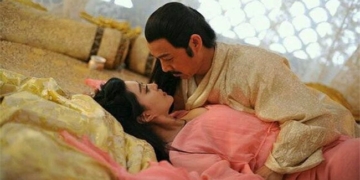Famous archaeological discoveries such as the tomb of Tutankhamun owe much to the contributions of local Egyptians, yet they remain unrecognized by the world.
According to leading archaeologist Monica Hanna, as reported by AFP on November 6th, “Egyptians have been excluded from the historical narrative.”

Archaeologist Carter and his team examining the sarcophagus of Pharaoh Tutankhamun. (Photo: Wikipedia)
In one of the most iconic images of the 20th century, British archaeologist Howard Carter is seen inspecting the sarcophagus of Pharaoh Tutankhamun in 1922, while an Egyptian member of his team is hunched nearby, obscured in shadow.
This image serves as a metaphor for two centuries of Egyptology, where stories of skilled foreign explorers uncovering the secrets of pharaohs dominate, while the contributions of Egyptians remain forgotten.
Now, on the centenary of Carter’s discovery of Tutankhamun’s tomb (November 4, 1922 – November 4, 2022) and the 200th anniversary of the deciphering of the Rosetta Stone that unlocked ancient hieroglyphs, Egyptians are demanding recognition for their contributions.
The Nameless Egyptians
“Egyptians did most of the work but are not remembered,” said archaeologist Abdel Hamid Daramalli, who currently leads excavation projects at the tombs in Qurna near Luxor.
According to Egyptologist Heba Abdel Gawad, even Jean François Champollion, the Frenchman who “cracked the code” of the Rosetta Stone in 1822, “whitewashed history as if no research efforts into ancient Egypt existed until Europeans arrived.”
“The ‘nameless Egyptians'” in Carter’s famous photograph are likely Hussein Abu Awad or Hussein Ahmed Said, according to art historian Christina Riggs, a Middle East expert at Durham University in the UK.
Carter and Hussein were both key figures in the team, alongside Ahmed Gerigar and Gad Hassan, throughout nine excavation seasons, but unlike their foreign counterparts, the Egyptian members “went unnoticed.”
“Egyptians are not recorded and are hardly known in their own history,” Riggs emphasized, noting that the structural inequalities in the field of Egyptology still persist today.
However, one Egyptian name has become famous as the accidental discoverer of Tutankhamun’s tomb: Hussein Abdel Rasoul. Although not mentioned in Carter’s diary, the story of ‘the water boy’ is recognized as historical fact, Riggs stated.
On November 4, 1922, 12-year-old Hussein Abdel Rasoul was doing his daily task of carrying large jars of water to the excavation site for the workers. The jars were secured with ropes and placed on a donkey for transport. Upon arrival, he unloaded the jars from the donkey and set them on the sand. Due to the pointed bottoms of the jars, Hussein had to dig a bit of sand to set them upright, accidentally discovering a flat stone that appeared sculpted, which was the top step leading down to the tomb, according to Live Science.
Hussein reported his discovery to the workers. The next day, Carter’s team excavated the entire staircase, and by November 26, 1922, he peered into a room filled with golden treasures through a small hole in the tomb’s entrance.
Riggs noted that in the rare instances where Egyptology recognizes Egyptians for remarkable discoveries, they are often children or tomb robbers.
“The issue is that others hold the records; we do not,” Sayed Abdel Rasoul, Hussein’s grandson, told AFP.

Most of the excavation work for Tutankhamun’s tomb was carried out by Egyptians, yet their names are little known. (Photo: Hulton-Deutsch Collection/CORBIS/Corbis)
According to Egyptologist Abdel Gawad, local Egyptians can see the outlines in the sand and “know whether something is there or not.” Their knowledge and excavation skills have been passed down through generations in Qurna and Qift, where British archaeologist William Flinders Petrie first trained locals in the 1880s.
Excavation worker Mostafa Abdo Sadek, whose discovery was celebrated in the Netflix documentary “Secrets of the Saqqara Tomb,” is a descendant of tomb diggers from Qift.
His family moved 600 kilometers north in the early 20th century to excavate the vast cemetery south of the Giza pyramids, but their contributions in a century of exploration in Saqqara remain largely undocumented.
The Children of Tutankhamun
Archaeologist and former Egyptian Minister of Antiquities Zahi Hawass stated that while the French controlled the country’s antiquities service for decades, Egyptians “have always served foreigners.”
“We must remember the historical and social context of that time, with Egypt under British occupation,” noted Egyptologist Fatma Keshk.
The struggle for Egypt’s cultural heritage peaked in the early 20th century when Egyptians demanded their freedom. “We are the children of Tutankhamun,” diva Mounira al-Mahdiyya sang in 1922, the year the intact tomb of the famous pharaoh was discovered. That same year, Britain was forced to grant Egypt independence.
While significant treasures remain in Tutankhamun’s tomb in Cairo, Egypt has lost much of Carter’s archival material, which is considered his personal property. The records, crucial for academic research, were donated by Carter’s granddaughter to the Griffith Institute of Egyptology at the University of Oxford in the UK.
“They are still holding on to them. They left behind artifacts but have taken advantage of our ability to study,” Hanna added.
War Looting
Over the centuries, countless artifacts have left Egypt. Some, like the Luxor Obelisk in Paris and the Temple of Debod in Madrid, were gifts from governments, but most were lost in museums across Europe through the colonial partition system. Hundreds of thousands of other artifacts have been smuggled out of Egypt into private collections worldwide, according to Abdel Gawad.
Former Egyptian Minister of Antiquities Hawass is leading a campaign to repatriate the Rosetta Stone and the Dendera Zodiac. His petition has garnered over 78,000 signatures.
“Returning these two artifacts to Egypt would demonstrate the commitment of Western museums to rectify their collections and amend the past,” the petition states.
The Rosetta Stone has been housed in the British Museum since 1802. Museum authorities claim that “it was gifted to the British as a diplomatic present,” but for Abdel Gawad, “it is war looting.”
Meanwhile, the Frenchman Sebastien Louis Saulnier removed the Dendera Zodiac from the Temple of Hathor in Qena in 1820. This celestial map has since been displayed on the ceiling of the Louvre Museum in Paris since 1922.
“It was a crime that the French committed in Egypt,” archaeologist Hanna emphasized. “This behavior is inconsistent with 21st-century ethics.”





















































